The IOD–ENSO Interaction: The Role of the Indian Ocean Current’s System
Abstract
:1. Introduction
2. Materials and Methods
3. Results and Discussion
3.1. Critical Layers and IOD
3.2. IOD–ENSO Interaction and Critical Layers
4. Conclusions
Author Contributions
Funding
Institutional Review Board Statement
Informed Consent Statement
Data Availability Statement
Acknowledgments
Conflicts of Interest
References
- Saji, N.H.; Goswami, B.N.; Vinayachandran, P.N. A dipole mode in the tropical Indian Ocean. Nature 1999, 401, 360–363. [Google Scholar] [CrossRef] [PubMed]
- Guo, F.; Qinyu, L.; Yang, J.; Fan, L. Three types of Indian Ocean Basin modes. Clim. Dyn. 2018, 51, 4357–4370. [Google Scholar] [CrossRef]
- Saji, N.H.; Yamagata, T. Structure of SST and Surface Wind Variability during Indian Ocean Dipole Mode Events: COADS Observations. J. Clim. 2003, 16, 2735–2751. [Google Scholar] [CrossRef]
- Rao, S.A.; Behera, S.K. Subsurface influence on SST in the tropical Indian Ocean: Structure and Interannual variability. Dyn. Atmos. Ocean. 2005, 39, 103–135. [Google Scholar] [CrossRef]
- Birkett, C.; Murtugudde, R.; Allan, T. Indian Ocean climate event brings floods to East Africa’s lakes and the Sudd Marsh. Geophys. Res. Lett. 1999, 26, 1031–1034. [Google Scholar] [CrossRef]
- Conway, D. Extreme rainfall events and lake level changes in East Africa: Recent events and historical precedents. East Afr. Great Lakes Limnol. Palaeolimnol. Biodivers. 2002, 12, 63–92. [Google Scholar]
- Conway, D.; Allison, E.H.; Felstead, R. Rainfall variability in East Africa: Implications for natural resources management and livelihoods. Philos. Trans. R. Soc. A Math. Phys. Eng. Sci. 2005, 363, 49–54. [Google Scholar] [CrossRef]
- Hashizume, M.; Chaves, L.F.; Minakawa, N. Indian Ocean Dipole drives malaria resurgence in East African highlands. Sci. Rep. 2012, 2, 269. [Google Scholar] [CrossRef] [Green Version]
- Page, S.E.; Siegert, F.; Rieley, J. The amount of carbon released from peat and forest fires in Indonesia during 1997. Nature 2002, 420, 61–65. [Google Scholar] [CrossRef]
- Kunii, O.; Kanagawa, S.; Yajima, I. The 1997 haze disaster in Indonesia: Its air quality and health effects. Arch. Environ. Health Int. J. 2002, 57, 16–22. [Google Scholar] [CrossRef]
- Ummenhofer, C.C.; England, M.H.; Meyers, G.M. What causes southeast Australia’s worst droughts? Geophys. Res. Lett. 2009, 36, 1–5. [Google Scholar] [CrossRef] [Green Version]
- Wang, G.; Cai, W. Two-year consecutive concurrences of positive Indian Ocean Dipole and Central Pacific El Niño preconditioned the 2019/2020 Australian “black summer” bushfires. Geosci. Lett. 2020, 7, 19. [Google Scholar] [CrossRef]
- Wainwright, C.M.; Finney, D.L.; Kilavi, M. Extreme rainfall in East Africa, October 2019–January 2020 and context under future climate change. Weather 2021, 76, 26–31. [Google Scholar] [CrossRef]
- Polonsky, A.B.; Torbinsky, A.V. Influence of the Indian ocean dipole on Danube summer drains. MSOE 2018, 34, 89–94. [Google Scholar] [CrossRef]
- Polonsky, A.B. Response in the fields of surface air temperature, pressure and precipitation of the Eurasian region to the anomalies of ocean surface temperature associated with the Indian Ocean dipole. MSOE 2018, 31, 11–31. [Google Scholar]
- Abram, N.J.; Wright, N.M.; Ellis, B. Coupling of Indo-Pacific climate variability over the last millennium. Nature 2020, 579, 385–392. [Google Scholar] [CrossRef]
- Guo, F.; Liu, Q.; Sun, S. Three Types of Indian Ocean Dipoles. J. Clim. 2015, 28, 3073–3092. [Google Scholar] [CrossRef]
- Ummenhofer, C.C.; Biastoch, A.; Claus, W. Multidecadal Indian Ocean variability linked to the Pacific and implications for preconditioning Indian Ocean dipole events. J. Clim. 2017, 30, 1739–1751. [Google Scholar] [CrossRef] [Green Version]
- Saji, N.H.; Dachao, J.; Vishu, T. A model for super El Niños. Nat. Commun. 2018, 9, 2528. [Google Scholar]
- Cretat, J.; Terray, P.; Masson, S. Indian Ocean and Indian summer monsoon: Relationships without ENSO in ocean–atmosphere coupled simulations. Clim. Dyn. 2017, 49, 1429–1448. [Google Scholar] [CrossRef]
- Le, T.; Ha, K.J.; Bae, D.H. Causal effects of Indian Ocean Dipole on El Niño–Southern oscillation during 1950–2014 based on high-resolution models and reanalysis data. Environ. Res. Lett. 2020, 15, 385–392. [Google Scholar] [CrossRef]
- Iizuka, S.; Matsuura, T.; Yamagata, T. The Indian Ocean SST dipole simulated in a coupled general circulation model. Geophys. Res. Lett. 2000, 27, 3369–3372. [Google Scholar] [CrossRef] [Green Version]
- Vinayachandran, P.N.; Lizuka, S.; Yamagata, T. Indian Ocean dipole mode events in an ocean general circulation model. Deep Sea Res. Part II 2002, 49, 1573–1596. [Google Scholar] [CrossRef]
- Cai, W.; Cowan, T.; Raupach, M. Positive Indian Ocean dipole events precondition southeast Australia bushfires. Geophys. Res. Lett. 2009, 36, 1–6. [Google Scholar] [CrossRef]
- Allan, R. Is there an Indian Ocean dipole, and is it independent of the El Niño–Southern Oscillation? Clivar Exch. 2002, 6, 18–22. [Google Scholar]
- Saji, N.H.; Xie, S.-P.; Yamagata, T. Tropical Indian Ocean variability in the IPCC twentieth-century climate simulations. J. Clim. 2006, 19, 4397–4417. [Google Scholar] [CrossRef] [Green Version]
- Wang, H.; Murtugudde, R.; Kumar, A. Evolution of Indian Ocean dipole and its forcing mechanisms in the absence of ENSO. Clim. Dyn. 2016, 47, 2481–2500. [Google Scholar] [CrossRef]
- Yoo, J.-H.; Moon, S.; Ha, K.-J.; Yun, K.-S.; Lee, J.-Y. Cases for the sole effect of the Indian Ocean Dipole in the rapid phase transition of the El Niño–Southern Oscillation. Theor. Appl. Climatol. 2020, 141, 999–1007. [Google Scholar] [CrossRef]
- Philander, S.G. El Niño, La Nina, and the Southern Oscillation; Academic Press: San Diego, CA, USA, 1989; 293p. [Google Scholar]
- Polonsky, A.B.; Torbinsky, A.V. Critical layer in equatorial-tropical zone and Indian Ocean dipole. MSOE 2019, 36, 88–93. [Google Scholar] [CrossRef]
- Polonsky, A.B.; Torbinsky, A.V.; Gubarev, A.V. Identification of formation mechanisms of Indian Ocean dipole. MSOE 2020, 40, 13–19. [Google Scholar]
- Chu, J.-E.; Ha, K.-J.; Lee, J.-Y.; Wang, B.; Kim, B.-H.; Chung, C.E. Future change of the Indian Ocean basin-wide and dipole modes in the CMIP5. Clim. Dyn. 2014, 43, 535–551. [Google Scholar] [CrossRef] [Green Version]
- Polonsky, A.B.; Torbinsky, A.V. Velocity of propagation of temperature anomalies in the tropical zone of the Indian Ocean. Phys. Oceanogr. 2009, 63, 63–71. [Google Scholar] [CrossRef]
- Polonsky, A.B.; Meyers, G.; Torbinsky, A.V. Interannual variability of the heat content of the upper layer in the equatorial Indian Ocean and the Indian-Ocean dipole. Phys. Oceanogr. 2007, 17, 129–140. [Google Scholar] [CrossRef]
- Rao, S.A.; Behera, S.K.; Masumoto, Y. Interannual variability in the subsurface Indian Ocean with a special emphasis on the Indian Ocean Dipole. Deep Sea Res. Part II 2002, 49, 1549–1572. [Google Scholar] [CrossRef]
- Bracco, A.; Kucharski, F.; Molteni, F.; Hazeleger, W.; Severijns, C. Internal and forced modes of variability in the Indian Ocean. Geophys. Res. Lett. 2005, 32, 1–4. [Google Scholar] [CrossRef] [Green Version]
- Bubnov, V.A. Circulation in the Equatorial Zone of the World Ocean; Hydrometeoizdat: Leningrad, Russia, 1990. [Google Scholar]
- Polonsky, A.B.; Torbinsky, A.V.; Gubarev, A.V. Verification of reanalysis data for the tropical zone of the Indian Ocean. Part 2. Characteristics of the averaged seasonal cycle and interannual variability. MSOE 2020, 42, 119–127. [Google Scholar] [CrossRef]
- Saji, N.H. The Indian Ocean Dipole. Oxf. Res. Encycl. Clim. Sci. 2018, 46. [Google Scholar] [CrossRef]
- Yamagata, T.; Behera, S.K.; Luo, J.J. Coupled ocean-atmosphere variability in the tropical Indian Ocean. E Earth’s Clim. Ocean.-Atmos. Interact. 2004, 147, 189–211. [Google Scholar]
- Lim, E.-P.; Hendon, H.H. Causes and Predictability of the Negative Indian Ocean Dipole and Its Impact on La Niña During 2016. Sci. Rep. 2017, 7, 12619. [Google Scholar] [CrossRef] [PubMed] [Green Version]

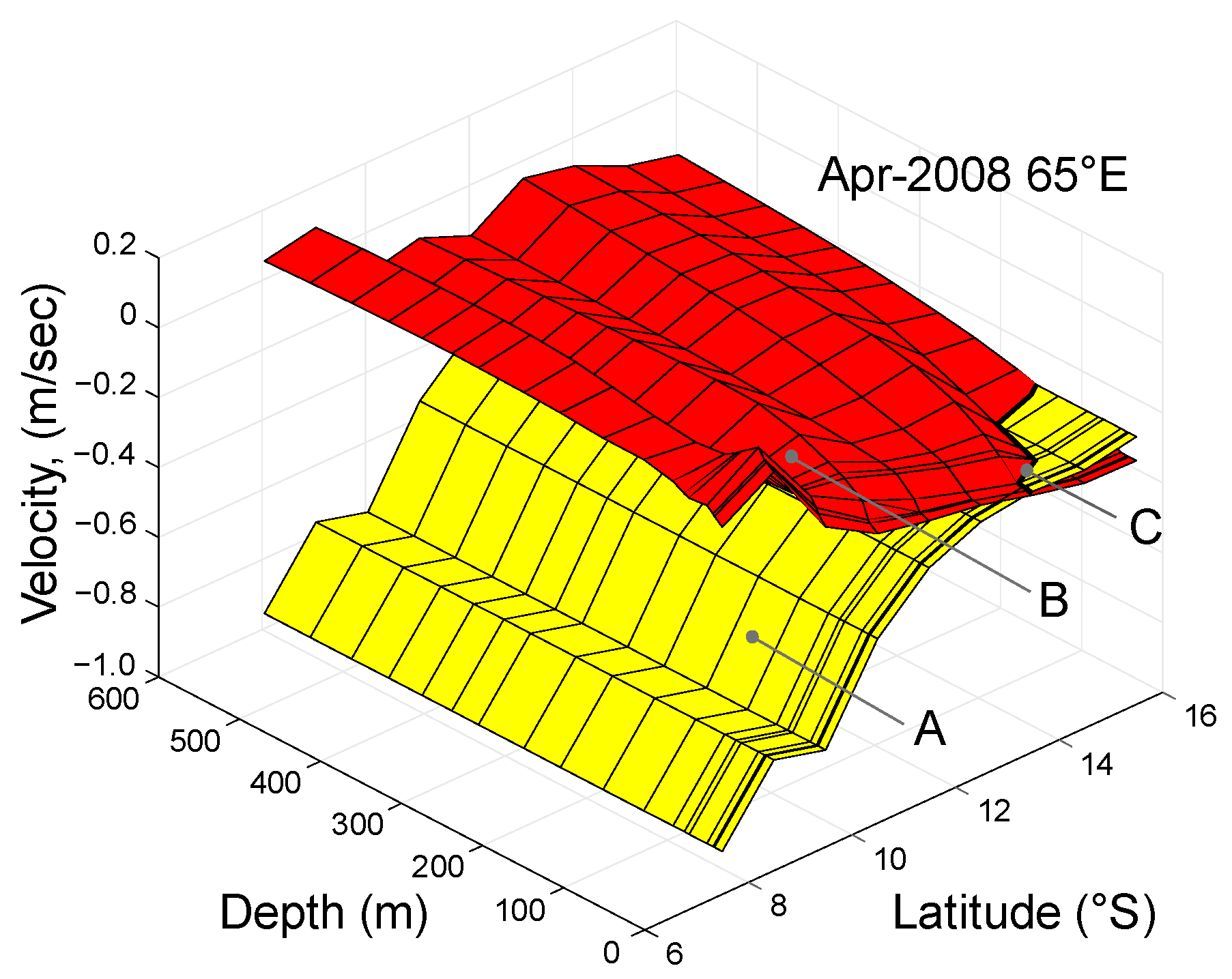



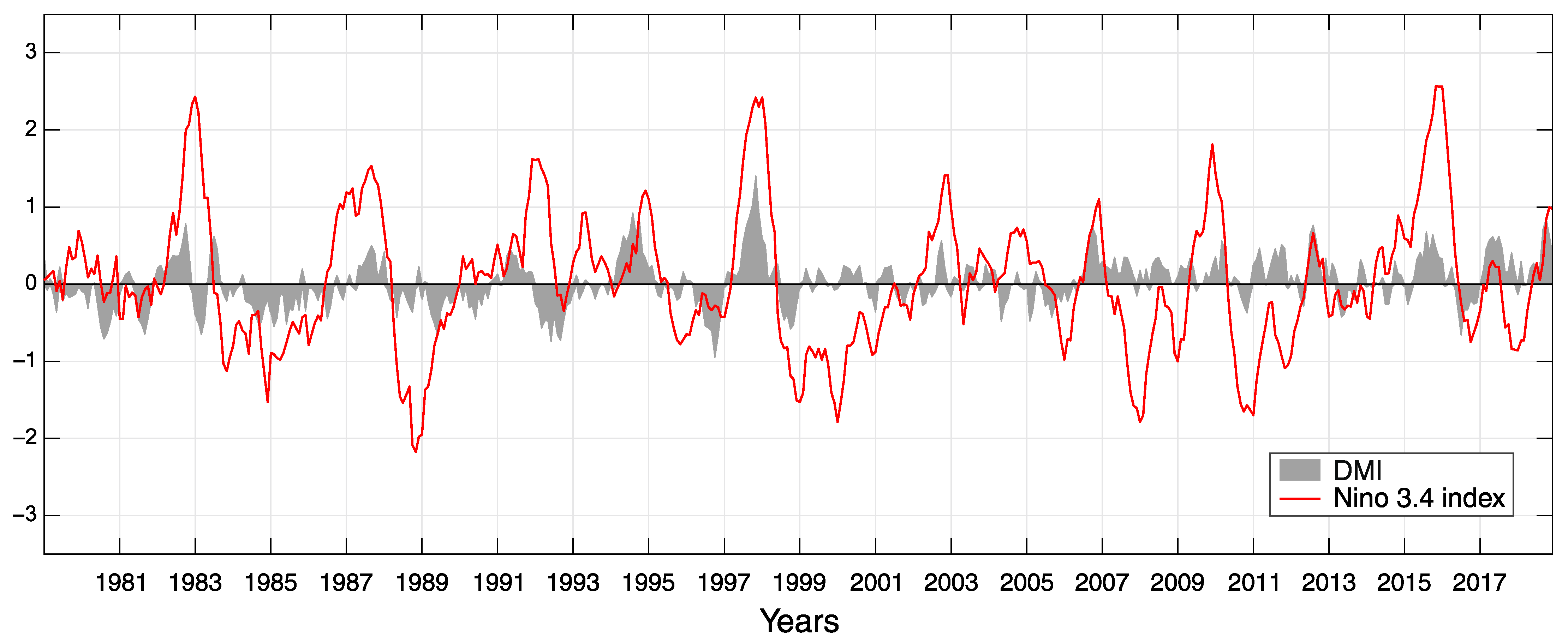
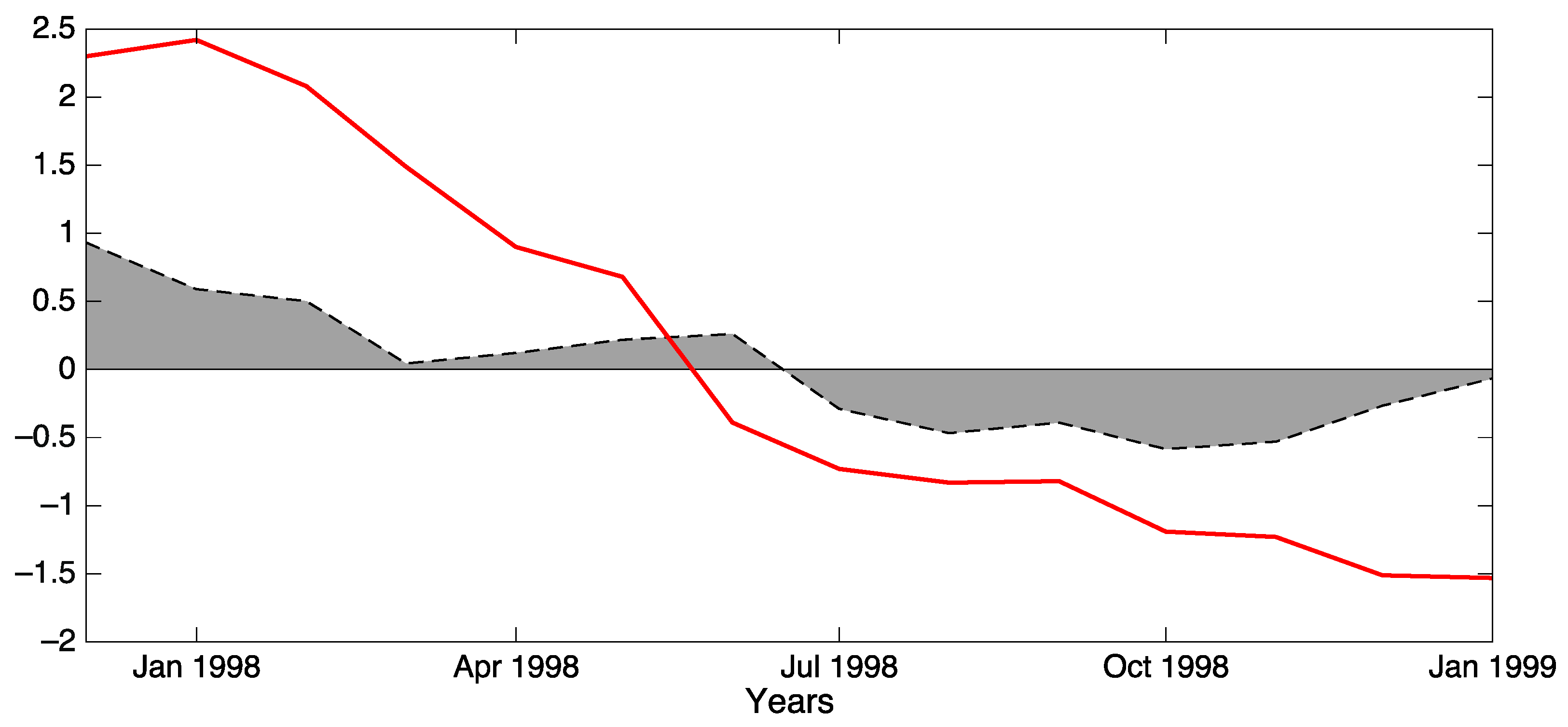
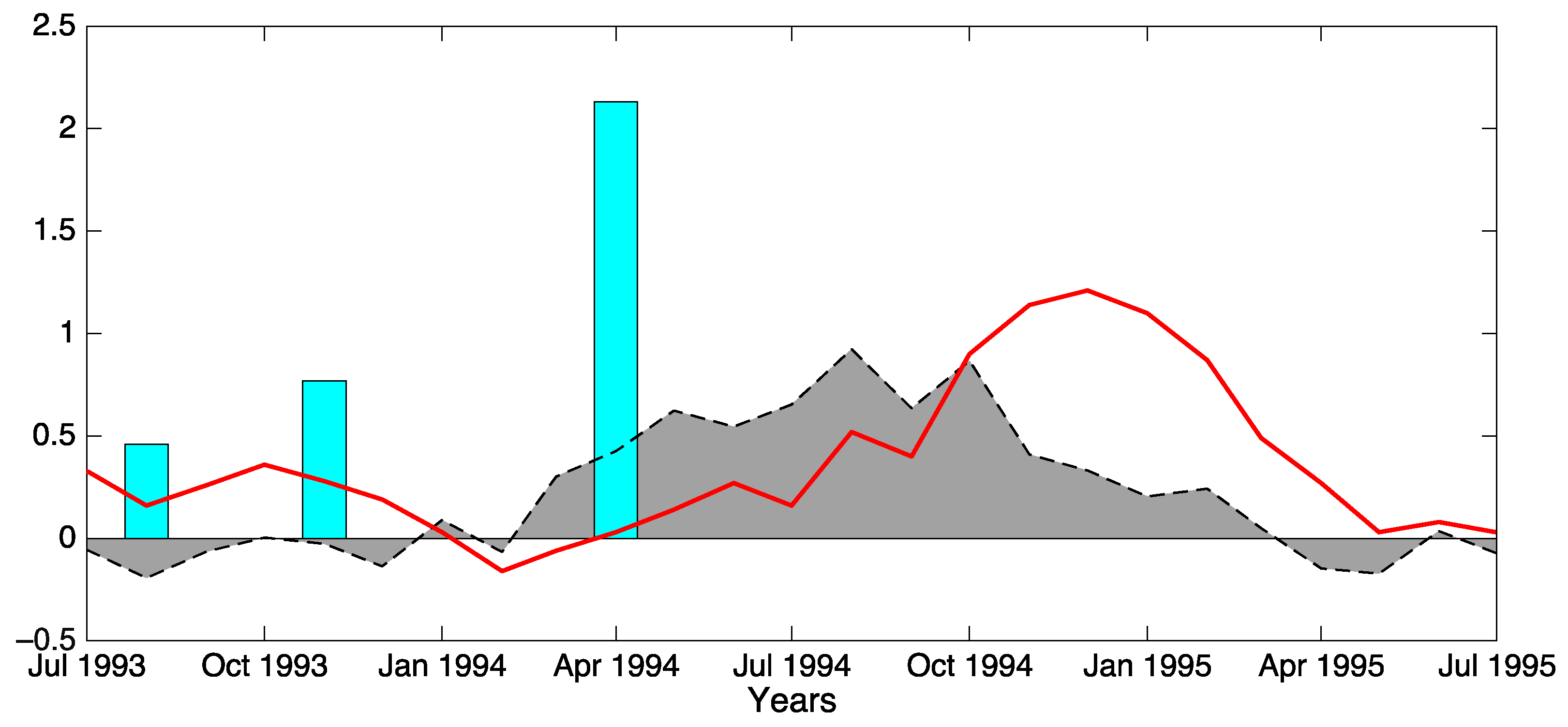

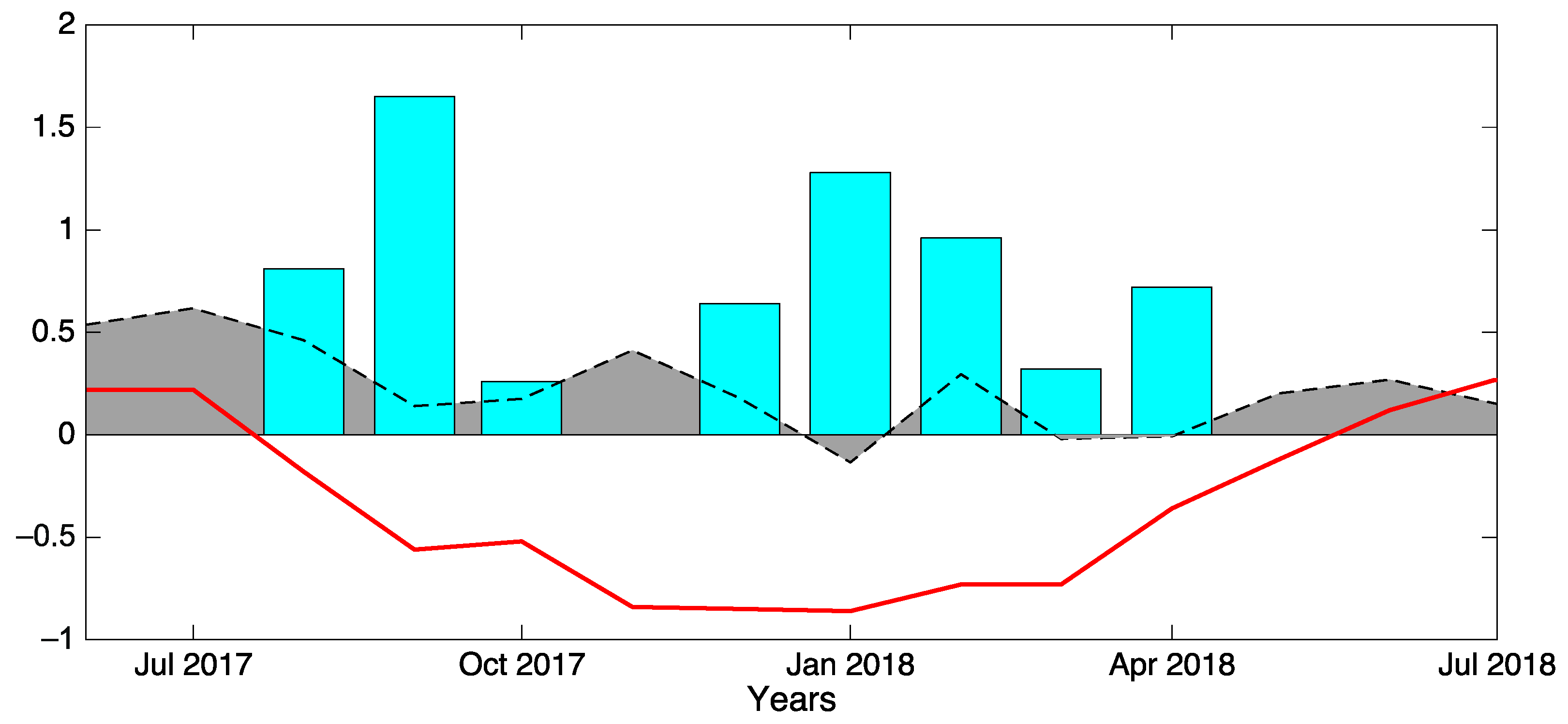
| IOD Phase | Year | Critical Layer Length (km) | Summary Critical Layer Length (km) | Average Critical Layer Length (km) |
|---|---|---|---|---|
| Negative | 1981 | 22.4 | ||
| 1989 | 36.1 | |||
| 1992 | 8.1 | |||
| 1996 | 526.7 | |||
| 1998 | 0 | 1427.3 | 158.9 | |
| 2005 | 204.0 | |||
| 2010 | 459.4 | |||
| 2014 | 121.7 | |||
| 2016 | 48.75 | |||
| 1982 | 410.9 | |||
| 1983 | 30.4 | |||
| 1994 | 210.4 | |||
| Positive | 1997 | 363.4 | 2831.9 | 353.9 |
| 2006 | 602.3 | |||
| 2012 | 293.6 | |||
| 2015 | 176.3 | |||
| 2017 | 744.1 |
Publisher’s Note: MDPI stays neutral with regard to jurisdictional claims in published maps and institutional affiliations. |
© 2021 by the authors. Licensee MDPI, Basel, Switzerland. This article is an open access article distributed under the terms and conditions of the Creative Commons Attribution (CC BY) license (https://creativecommons.org/licenses/by/4.0/).
Share and Cite
Polonsky, A.; Torbinsky, A. The IOD–ENSO Interaction: The Role of the Indian Ocean Current’s System. Atmosphere 2021, 12, 1662. https://doi.org/10.3390/atmos12121662
Polonsky A, Torbinsky A. The IOD–ENSO Interaction: The Role of the Indian Ocean Current’s System. Atmosphere. 2021; 12(12):1662. https://doi.org/10.3390/atmos12121662
Chicago/Turabian StylePolonsky, Alexander, and Anton Torbinsky. 2021. "The IOD–ENSO Interaction: The Role of the Indian Ocean Current’s System" Atmosphere 12, no. 12: 1662. https://doi.org/10.3390/atmos12121662
APA StylePolonsky, A., & Torbinsky, A. (2021). The IOD–ENSO Interaction: The Role of the Indian Ocean Current’s System. Atmosphere, 12(12), 1662. https://doi.org/10.3390/atmos12121662







